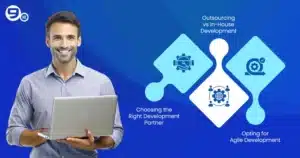Building custom software for your business is crucial to comply with specific needs and existing processes, offering high security, flexibility, and scalability within the estimated budget. New York is the hub of attracting diverse industries, access to global markets, and strong business ecosystems. One of the progressive nations is quickly adopting investment opportunities, an innovative culture, and international clients for custom software development services. So, how much does software development cost in New York? In the blog ahead, we will discuss in detail to understand different aspects of software development, factors affecting cost, and ways to reduce the development costs.
Introduction to Software Development Costs in New York
Custom software development refers to the process of designing a layout, project planning, UI/UX design, development, testing and QA, deployment, and further maintenance. Custom development costs depend on the right technology, vendor choice, project scope, and timeline for the software project. While exploring software development services in New York, businesses are focusing on the initial development cost, along with hidden expenses like cloud hosting or security updates.
Any startup owners or MNCs would like to make a smart choice for acquiring software that aligns with specific needs and negotiable costs. Before analyzing software development costs in New York, it is essential to assess direct or indirect costs, and the mode of development, whether building an in-house team or hiring a freelance developer, which will cost around $50 to $250 per hour based on experience.
When hiring a software development company in New York, companies need to plan for their budget, timelines, ongoing costs, and other factors, as this might lead to delays and compromised software quality. It directly affects the overall budget balance with navigating for feature requirements.
Key Elements of Software Development Costs:
- Planning and analysis costs incurred to gather requirements, market research, define project scope, and conduct feasibility studies.
- Designing costs for UI/UX frameworks to cover the entire wireframing and prototyping for usability testing.
- Development cost comprises coding phases and implementation expenses for the software license and infrastructure cost.
- QA and testing costs to deliver bug-free and stable software releases.
- Deployment costs for making software live and accessible to cover expenses for CI/CD pipelines, domain registration, server setups, and version controls.
- Software support cost includes expenses for updates, feature enhancements, and technical costs.
- Operational cost to develop the required infrastructure where the software will run, like cloud hosting or data storage.
- Security and compliance costs for data protection and regulatory authentication.
Key Factors that Influence Custom Software Development Cost
Understanding key factors affecting custom software development cost helps businesses to make informed decisions and optimize their budget effectively. Every software development project requires different technical specifications, software design, and operational considerations influencing custom software.
Here are the listed factors that influence the overall cost:
Type and Complexity of the Project
Depending on the software types and project complexities, it can significantly impact custom software development. Basic software versions with limited features and functionality require less investment, while advanced software with complex features needs a high investment to comply with multiple models and user roles.
Multiple factors for project complexities include user interface, custom design elements, programming language and framework, app features and functionalities, and supporting documentation to affect the custom software development cost.
Example: Building an e-commerce website with product listing requires integrating with multiple vendors’ accounts and checkout features. On the other hand, software integrated with advanced features like IoT and AI integration will demand extended development timelines and expertise that require higher costs in comparison to basic eCommerce software.
Technology Stack and Tools Used
Another key factor affecting the software development costs is the technology stack that comprises elements of the technology stack, frameworks, and programming languages. Basic software requires a regular framework and open-source tools that require less development costs, while advanced software needs more investment to satisfy performance needs, long-term maintenance, and scalability demands.
Selecting technology and integrated tools can directly impact development costs and affect integration complexities, developers’ experience and availability, and licensing fees.
Example: Custom software built with regular frameworks and technology stacks like React, Node.js, or PostgreSQL will be more cost-effective. On the other side, enterprise-level custom software with cross-platform compatibility for platforms like Android, iOS, or Web and frameworks like React Native or Flutter can directly influence the development costs.
Developer Experience and Team Size
Depending on the team composition and experience level, the software development costs will increase or decrease. For developing custom software with specialized features and experienced designers, the team will charge more to deliver the right quality with scalability. Development cost will vary for freelancers, in-house, and outsourcing to build the right product while ensuring quality and long-term maintenance.
Example: For building a minimum viable product, businesses need to hire freelancers and incur less development costs within shorter timelines and compromise on quality aspects. On the other side, enterprise-level software creates the demand to set up an internal development team that will increase the cost for hiring QA testers, UI/UX designers, product engineers, and an IT support team.
Start Your Software Development Project
Talk to our Experts
Request A Free Quote
Design and User Experience Requirements
In custom development, user experience (UX) and software design quality are two competitive edges in the software space. Software with minimal design and basic layout, and standard components, will cost less, while the advanced one with custom graphics and animation requires additional time and cost investment.
Depending on the UI/UX complexities for the user journey, visual elements, optimization, or general usability for the application can influence the development costs. Designing the software with a high-quality design requires professional tools with a paid version that can create demand for additional costs.
Example: A simple finance software with limited features of dashboards, data input fields requires less development costs. While developing advanced software like Revolut or PayTM with features of biometric login, data visualization, or an interactive user interface, it increases development costs to deliver smooth navigation for end users.
Integration, Testing, and Maintenance
Modern custom software doesn’t function standalone; it integrates with other systems, including analytical, payment gateways, CRM, and ERPs, to ensure extended usage. This creates additional software development costs for adding complexities, additional APIs, compatibility checks, or security validations. Post-deployment of software, the ongoing maintenance and testing are a crucial factor to consider for security patches, feature enhancements, server monitoring, and regular updates.
Example: Developing a custom HR management software requires integrating with performance-tracking tools, attendance, and payroll tools to increase the development cost. Ahead of this, the testing phase will be conducted to check for security or performance testing, and ensure that the final product is more scalable.
Average Software Development Rates in New York
New York is growing famous as the leading tech center globally, with an experienced team of developers, tech experts, and freelancers. Here, companies will find variation for development rates in New York depending on industries like finance, healthcare, or real estate, project types, and scalability. Before finalizing vendors or right freelancers, it is essential to compare the average software development cost based on different categories.
Here is an overview of the average software development rates and a comparison of costs across different categories:
Hourly Rates by Developer Role
| Developer Role | Experience Level | Average Hourly Rate (USD) |
|---|---|---|
| Junior Developer | 0–2 years | $40 – $70 |
| Mid-Level Developer | 2–5 years | $70 – $110 |
| Senior Developer | 5+ years | $110 – $160 |
| UI/UX Designer | 3–6 years | $80 – $130 |
| QA Engineer / Tester | 2–5 years | $60 – $100 |
| DevOps Engineer | 4–7 years | $60 – $100 |
| Project Manager / Tech Lead | 5+ years | $120 – $180 |
Average Cost Based on Project Type (Web, Mobile, Enterprise)
| Project Type | Estimated Cost Range (USD) | Development Duration (Approx.) |
|---|---|---|
| Web Application | $40,000 – $120,000 | 3–6 months |
| Mobile Application (iOS/Android) | $60,000 – $180,000 | 4–8 months |
| Enterprise Software | $150,000 – $500,000 | 6–12 months |
| MVP (Minimum Viable Product) | $25,000 – $60,000 | 2–4 months |
| E-commerce Platform | $80,000 – $250,000 | 5–9 months |
Comparison: Startup Vs Enterprise-Level Projects
| Category | Startup-Level Project | Enterprise-Level Project |
|---|---|---|
| Team Composition | 3–6 members (Developer, Designer, QA) | 10–20+ members (Full-stack team, Architects, DevOps, PMs) |
| Average Cost Range | $30,000 – $150,000 | $200,000 – $800,000+ |
| Project Duration | 2–6 months | 6–12+ months |
| Technology Stack | Open-source tools and cloud-based solutions (e.g., React, Node.js, Firebase) | Enterprise-grade tools with advanced security (e.g., Java Spring Boot, .NET, AWS, Kubernetes) |
| Scalability & Maintenance | Moderate scalability, limited post-launch updates | High scalability with long-term maintenance contracts |
| Target Use Case | MVPs, SaaS startups, or niche applications | Financial, healthcare, or government-level enterprise systems |
Hidden or Additional Costs to Consider
Fixing the budget for software development and missing out on additional hidden costs? The process of software development comes with hidden expenses that arise from development to maintenance phases, and through a skeptical comparison, companies can optimize their software development cost in New York.
In many cases, businesses need to evaluate these requirements in advance to allocate contingency to cover these additional hidden expenses.
Licensing and Third-Party Tools
For enhanced compatibility, custom software requires integration with third-party tools using APIs as the requirement arises. If the existing system is not designed for working together, this can increase software development costs. From finding the right tools to acquire a license for integrating software, these hidden expenses emerge for scalability.
For instance, real estate management software requires integration features of location services, communication, and payment gateway support. Each of these third-party integrations adds to the demand for licensing and subscription fees that increase over time.
Post-Launch Maintenance and Support
Software development cost doesn’t end with the deployment phases; in reality, this post-launch software maintenance as hidden costs extends the budget. These steps include security patches, performance monitoring, and software libraries to improve functionalities or feature enhancements. Most of the companies keep aside a budget of around 10 to 15% of the initial development cost annually for technical support and software maintenance.
Majorly, healthcare and fintech apps require compliance requirements and regulatory support as the software scales. These improvements require the developer’s time and additional support for hidden costs.
Cloud Hosting and Security Expenses
Cloud hosting and deployment through platforms like Google Cloud, AWS, or Microsoft Azure has become a new trend, offering more scalability and flexibility. Certainly, with software development, it creates recurring costs for storage, bandwidth, and data usage. A major portion of security expenses is part of a hidden cost structure through multi-factor authentication, data encryption, firewalls, or compliance. To safeguard data transfer, it is essential to invest in this hidden cost.
Healthcare or retail sector software needs a robust infrastructure with cloud hosting to maintain a high number of transactions. So, this creates additional operational costs to support load balancing, database replication, and automated scaling.
Technical Debt
It is also referred to as design debt or code debt, which implies the future cost for rework to maintain the quality of software. Technical debt is a hidden concept, as this accumulates as “interest” in the form of reduced development speed, software complexities, and future rework. The development team tries to deviate these costs to the maximum level, but some portion of technical debt is unavoidable, which results in slowing down projects.
Imagine any startup aims to launch their payment software and is in a rush to meet the deadline, skipping the part of documentation and automated testing. However, as the user base grows, it generates additional hidden costs for code refactoring, QA cycles, and fixing bugs.
How to Reduce Software Development Costs in New York
To turn software development constraints into an estimated budget, companies are searching for ways to reduce the overall cost. Custom software with advanced features can impact business finance to a larger extent; it needs optimization to distribute costs and allocate resources evenly for building the right-fit software.
So here are the proven tips to reduce software development cost in New York:
Choosing the Right Development Partner
For any business investing in custom software, it is necessary to find an ideal software development partner, depending on the estimated budget, timeline. As the New York nation has a competitive technical ecosystem, companies can compare vendors by reviewing their quotes for negotiation and service quality. A development partner can measure their technical expertise, industry experience, flexible communication, and past project deliverables.
Opting for the right partner will reduce development costs through lessening resource wastage and diversified investment. It saves the majority of hidden costs, communication delays, and rework.
Opting for Agile Development
Besides the development partner, it is equally important to select the right development methodology among models to build modern and adaptable software. Based on the industry standards, agile methodology is an effective way to reduce development costs without any compromise on quality standards. It splits development into shorter cycles that eliminate costlier reworks. This development approach offers more flexibility to integrate features, frequent release updates, and comply with market demand.
Outsourcing vs In-House Development
In an expensive region like New York, companies can save their development cost from in-house development and outsourcing. Building an in-house team might be expensive; however, it is cost-effective in the long run to handle scalability and alignment with business goals. Outsourcing opens the door for accessing global talent at competitive rates. This provides flexibility to scale with the team through the project’s phases and avoid long-term employment costs.
Build a Minimum Viable Product (MVP)
Developing an MVP means building a basic version of the product with minimal features to solve any targeted problem. Mainly, companies launch this MVP software to test for market demand before investing in large-scale software. It gradually reduces the development costs, resource wastage and validates the market’s expectations. By focusing on essential features, the development team minimizes labor costs and shortens the development timelines, resulting in cost-effectively.
Lean Approach
Lean principle for software development focusing on eliminating resource wastage by adding low-value elements without compromising on quality. Lean development emphasizes a customer-centric approach, ensuring that every step of development aligns with end-user preferences and needs. During software development, this reduces overproduction by avoiding excess coding and features to focus on core objectives.
Software Development Cost in New York vs Other Cities
In comparison to other tech cities in the US, New York is coming as the most expensive considering factors for location, experience levels, and specialized services. Let’s have a closer look with the help of a comprehensive table to measure cost on different levels:
New York vs San Francisco
| Cost Component | New York (USD / % of Total Cost) | San Francisco (USD / % of Total Cost) |
|---|---|---|
| Development (Coding) | $50,000 – $90,000 (50%) | $55,000 – $100,000 (50%) |
| Design & UX | $10,000 – $20,000 (10–15%) | $12,000 – $25,000 (10–15%) |
| Testing & QA | $8,000 – $15,000 (8–10%) | $9,000 – $18,000 (8–10%) |
| Project Management | $5,000 – $10,000 (5–7%) | $6,000 – $12,000 (5–7%) |
| Infrastructure / Hosting | $3,000 – $7,000 (3–5%) | $3,500 – $8,000 (3–5%) |
| Licensing / Third-Party Tools | $4,000 – $8,000 (4–5%) | $4,500 – $9,000 (4–5%) |
| Maintenance & Support (Annual) | $10,000 – $25,000 (10–15%) | $12,000 – $28,000 (10–15%) |
| Total Estimated Project Cost | $80,000 – $180,000 | $90,000 – $200,000 |
New York vs Austin
| Cost Component | New York (USD / % of Total Cost) | Austin (USD / % of Total Cost) |
|---|---|---|
| Development (Coding) | $50,000 – $90,000 (50%) | $35,000 – $70,000 (50%) |
| Design & UX | $10,000 – $20,000 (10–15%) | $8,000 – $15,000 (10–15%) |
| Testing & QA | $8,000 – $15,000 (8–10%) | $6,000 – $12,000 (8–10%) |
| Project Management | $5,000 – $10,000 (5–7%) | $4,000 – $8,000 (5–7%) |
| Infrastructure / Hosting | $3,000 – $7,000 (3–5%) | $2,500 – $6,000 (3–5%) |
| Licensing / Third-Party Tools | $4,000 – $8,000 (4–5%) | $3,500 – $7,000 (4–5%) |
| Maintenance & Support (Annual) | $10,000 – $25,000 (10–15%) | $7,000 – $18,000 (10–15%) |
| Total Estimated Project Cost | $80,000 – $180,000 | $60,000 – $130,000 |
Conclusion
Companies are spending hours on research to evaluate the software development cost in New York to prevent budget overruns and resource wastage. From the project’s scope, timelines, to development team composition, the business can analyze development costs into different parameters. Additionally, through cost optimization strategies, it supports companies in building improved quality software within budget.
In this guide blog, we have suggested aspects of software development cost in New York to help businesses plan for their next software deployment. If companies make the right decision, they can ensure scalability and control costs for maximizing ROI.
FAQs
What is the average cost of custom software development in New York?
The average cost typically ranges between $50,000 to $2,00,000 depending on team size, project types, and feature integrations.
What factors influence the cost of software development in New York?
Some key factors affecting the software development cost in New York include team expertise, technology stack, project complexities, UI/UX design, and post-launch maintenance.
Is software development more expensive in New York than in other US cities?
Yes, New York is more expensive than other US cities like Austin or San Francisco due to its high cost of living and salary standards.
What’s the difference between custom software development and off-the-shelf software?
The core difference is that custom software is built for specific business requirements, while off-the-shelf software is pre-built, more standardized, and less flexible.
Great Together!













